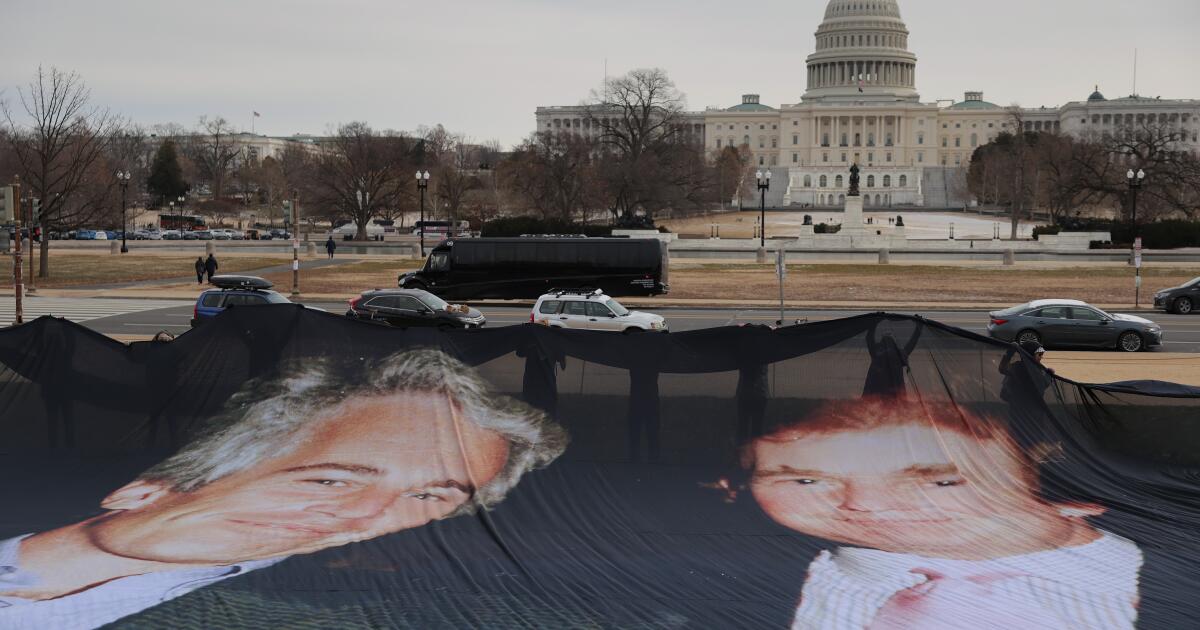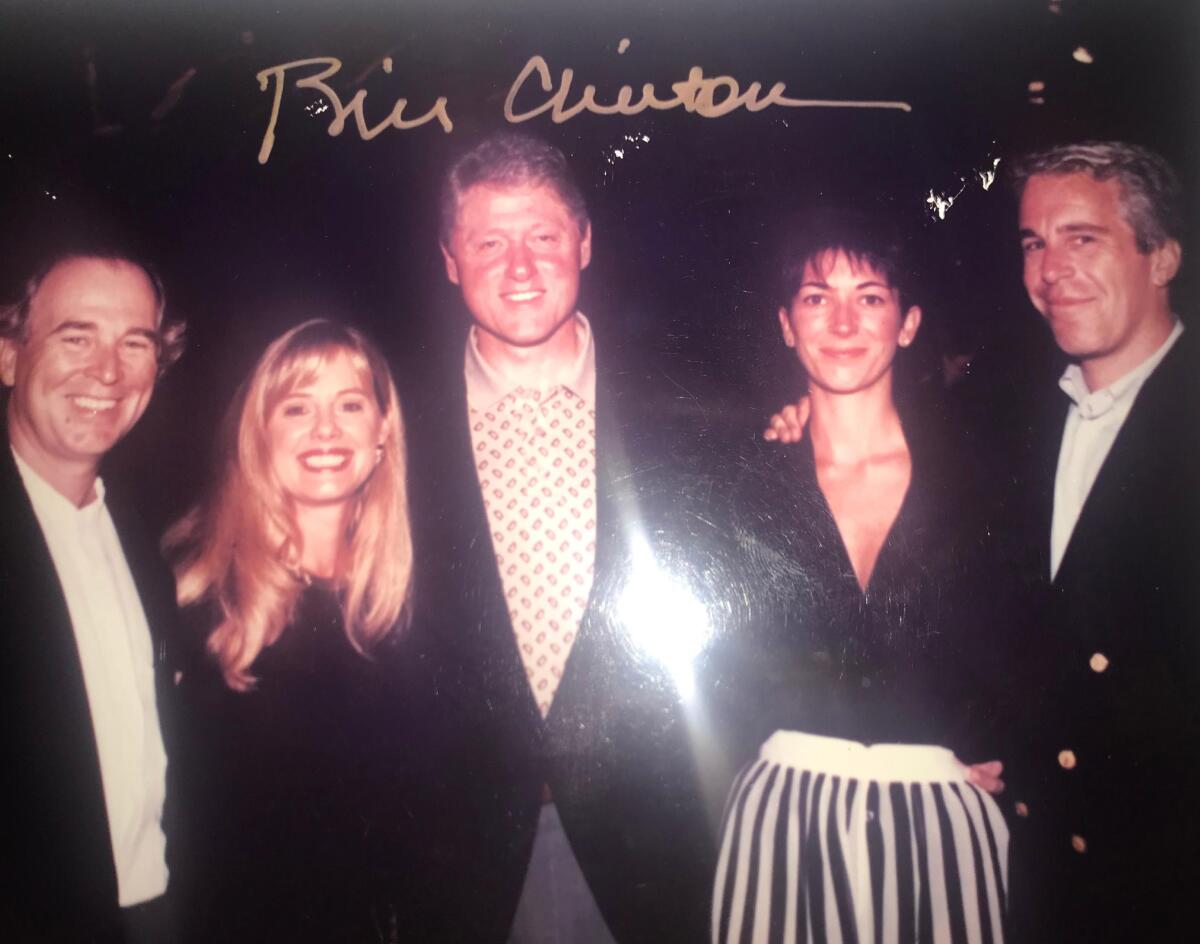Column: What Epstein ‘hoax’? The facts are bad enough
Bill Clinton, Bill Gates, Noam Chomsky and Woody Allen were among the familiar faces in the latest batch of photographs released by Democrats on the House Oversight Committee in connection to the late Jeffrey Epstein. With the Justice Department preparing to make additional files public, the images underscore an uncomfortable truth for us all: The convicted sex offender moved comfortably among some of the most intelligent men in the world. Rhodes scholars, technology leaders and artists.
Also in the release was a photograph of a woman’s lower leg and foot on what appears to be a bed, with a paperback copy of Vladimir Nabokov’s “Lolita” visible in the background. The 1955 novel centers on a middle-aged man’s sexual obsession with a 12-year-old girl. Epstein, a serial sexual abuser, famously nicknamed one of his private planes “The Lolita Express.” And we are to believe that some of the globe’s brightest minds could not put the dots together?
Donald Trump, who once described himself as “a very stable genius,” included.
“I’ve known Jeff for 15 years. Terrific guy,” Trump told New York magazine in 2002. “He’s a lot of fun to be with. It is even said that he likes beautiful women as much as I do, and many of them are on the younger side.”
Later, the two had a public falling out, and Trump has repeatedly denied any wrongdoing. Great. But denial after the fact is only one side of this story. The other is harder to digest: Either the self-proclaimed “very stable genius” spent nearly two decades around Epstein without recognizing what was happening in plain sight — or he recognized it and chose silence. Neither explanation reflects on intelligence as much as it does on character. No wonder Trump’s defenders keep raising the most overused word in American politics today: hoax.
“Once again, House Democrats are selectively releasing cherry-picked photos with random redactions to try and create a false narrative,” said White House spokesperson Abigail Jackson. “Here’s the reality: Democrats like Stacey Plaskett and Hakeem Jeffries were soliciting money and meetings from Epstein after he was a convicted sex offender. The Democrat hoax against President Trump has been repeatedly debunked, and the Trump administration has done more for Epstein’s victims than Democrats ever have by repeatedly calling for transparency, releasing thousands of pages of documents and calling for further investigations into Epstein’s Democrat friends.”
Jackson has a point.
Democrats were cherry-picking which photos to release, even if many of the men pictured were aligned with progressives. That includes the president, who was a Democrat when he and Epstein were running together in New York in the 2000s. Trump didn’t register as a Republican until 2009. Now whether the choice of photos and timing was designed to shield political friends or weaponize against perceived enemies isn’t clear. What is clear is that it doesn’t take a genius to see that none of this is a hoax.
The victims are real. The flight logs are real. The millions that flowed into Epstein’s bank account have wire transfer confirmation numbers that can be traced. What Democrats are doing with the information is politics as usual. And you don’t want politics to dictate who gets justice and who gets vilified.
Whatever the politicians’ intentions, Americans can decide how to react to the disclosures. And what the men around Epstein did with the information they gathered on his jet or his island fits squarely at the heart of the national conversation about masculinity. What kind of men could allow such abuse to continue?
I’m not saying the intelligent men in Epstein’s ecosystem did something criminal, but the lack of whistleblowing before his arrest raises questions about their fortitude for right and wrong. And the Trump White House trying to characterize this conversation as a partisan witch hunt — a hoax — is an ineffective strategy because the pattern with their use of that word is so clear.
We saw what happened on Jan. 6, and Trump tells us the investigation is a hoax. We hear the recording of him pressuring Georgia officials to find votes, and he tells us the investigation is a hoax. Trump campaigned on affordability issues — the cost of bacon, no taxes on tips — but now that he’s in office such talk is a hoax by Democrats. As if we don’t know the price of groceries in real time. Ten years ago, Trump told us he had proof that President Obama wasn’t born in the U.S. We’re still waiting.
In his book, “Art of the Deal,” Trump framed his lies as “truthful hyperbole” but by now we should understand for him hyperbole matters more than truth — and his felony convictions confirm that some of his claims were indeed simply false.
So if there is a hoax, it is the notion that none of the brilliant men whom Epstein kept in his orbit had any idea what was going on.
YouTube: @LZGrandersonShow
Insights
L.A. Times Insights delivers AI-generated analysis on Voices content to offer all points of view. Insights does not appear on any news articles.
Viewpoint
Perspectives
The following AI-generated content is powered by Perplexity. The Los Angeles Times editorial staff does not create or edit the content.
Ideas expressed in the piece
-
The release of photographs and documents from the House Oversight Committee demonstrates that Epstein moved freely among some of the world’s most accomplished and intelligent individuals, including Rhodes scholars, technology leaders and artists.
-
Either these prominent men failed to recognize warning signs despite obvious indicators like Epstein’s “Lolita Express” nickname referencing a novel about child sexual abuse, or they recognized the reality and chose silence—neither explanation reflects well on their character.
-
Claims that this is a hoax lack credibility because the evidence is concrete: the victims are real[1], the flight logs are documented[1][3], and the millions flowing through Epstein’s bank accounts have verifiable wire transfer confirmation numbers.
-
The apparent lack of whistleblowing from the men in Epstein’s ecosystem before his 2019 arrest raises serious questions about their moral fortitude and willingness to stand against wrongdoing.
-
The Trump administration’s strategy of characterizing these disclosures as a partisan witch hunt is ineffective, given the pattern of applying the term “hoax” to numerous matters that subsequently proved to be substantiated, from investigations into January 6 to documented pressuring of Georgia officials.
-
Regardless of whether Democrats’ selection of which photographs to release was politically motivated, legitimate questions about masculinity and moral responsibility remain central to the national conversation.
Different views on the topic
-
Democrats selectively released cherry-picked photographs with random redactions designed to create a false narrative while attempting to shield their own political allies, including figures like Stacey Plaskett and Hakeem Jeffries who solicited money and meetings from Epstein after his conviction.
-
The timing and selection of photographs released by House Democrats appear strategically designed to weaponize the Epstein matter against political opponents while deflecting scrutiny from Democratic figures who also maintained connections to the convicted sex offender[2].
-
The Trump administration has demonstrated greater commitment to transparency on the Epstein matter through the release of thousands of pages of documents and calls for further investigations into Epstein’s connections to Democratic associates.
-
Characterizing this as purely a partisan response overlooks the fact that prominent figures across the political spectrum, including those who were Democrats when they associated with Epstein in the 2000s, had connections requiring examination[2].



